


In geology and mineralogy, druse is a crystal habit represented by the coating of fine crystals on a rock fracture surface, [1] or vein or within a vug or geode. [2]



In geology and mineralogy, druse is a crystal habit represented by the coating of fine crystals on a rock fracture surface, [1] or vein or within a vug or geode. [2]

Mineralogy is a subject of geology specializing in the scientific study of the chemistry, crystal structure, and physical properties of minerals and mineralized artifacts. Specific studies within mineralogy include the processes of mineral origin and formation, classification of minerals, their geographical distribution, as well as their utilization.
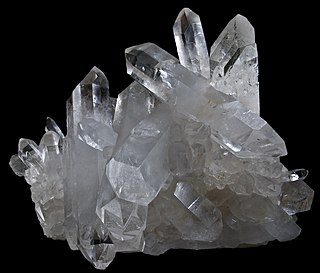
Quartz is a hard, crystalline mineral composed of silica (silicon dioxide). The atoms are linked in a continuous framework of SiO4 silicon–oxygen tetrahedra, with each oxygen being shared between two tetrahedra, giving an overall chemical formula of SiO2. Quartz is, therefore, classified structurally as a framework silicate mineral and compositionally as an oxide mineral. Quartz is the second most abundant mineral in Earth's continental crust, behind feldspar.

Titanite, or sphene (from Ancient Greek σφηνώ (sphēnṓ) 'wedge'), is a calcium titanium nesosilicate mineral, CaTiSiO5. Trace impurities of iron and aluminium are typically present. Also commonly present are rare earth metals including cerium and yttrium; calcium may be partly replaced by thorium.
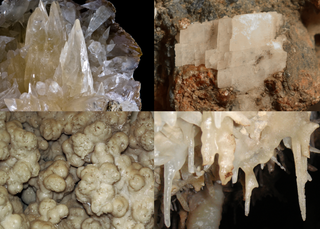
Calcite is a carbonate mineral and the most stable polymorph of calcium carbonate (CaCO3). It is a very common mineral, particularly as a component of limestone. Calcite defines hardness 3 on the Mohs scale of mineral hardness, based on scratch hardness comparison. Large calcite crystals are used in optical equipment, and limestone composed mostly of calcite has numerous uses.

In mineralogy, crystal habit is the characteristic external shape of an individual crystal or aggregate of crystals. The habit of a crystal is dependent on its crystallographic form and growth conditions, which generally creates irregularities due to limited space in the crystallizing medium.
Druse can refer to:

Selenite, satin spar, desert rose, and gypsum flower are crystal habit varieties of the mineral gypsum.

Vivianite (Fe2+
3(PO
4)
2·8H
2O) is a hydrated iron phosphate mineral found in a number of geological environments. Small amounts of manganese Mn2+, magnesium Mg2+, and calcium Ca2+ may substitute for iron Fe2+ in the structure. Pure vivianite is colorless, but the mineral oxidizes very easily, changing the color, and it is usually found as deep blue to deep bluish green prismatic to flattened crystals. Vivianite crystals are often found inside fossil shells, such as those of bivalves and gastropods, or attached to fossil bone. Vivianite can also appear on the iron coffins or on the corpses of humans as a result of a chemical reaction of the decomposing body with the iron enclosure.
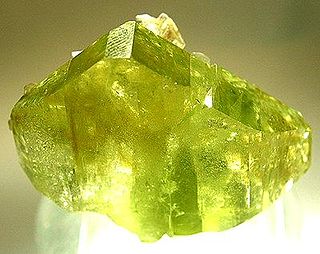
Brazilianite, whose name derives from its country of origin, Brazil, is a typically yellow-green phosphate mineral, most commonly found in phosphate-rich pegmatites.

Valentinite is an antimony oxide mineral with formula Sb2O3. Valentinite crystallizes in the orthorhombic system and typically forms as radiating clusters of euhedral crystals or as fibrous masses. It is colorless to white with occasional shades or tints of yellow and red. It has a Mohs hardness of 2.5 to 3 and a specific gravity of 5.76. Valentinite occurs as a weathering product of stibnite and other antimony minerals. It is dimorphous with the isometric antimony oxide senarmontite.
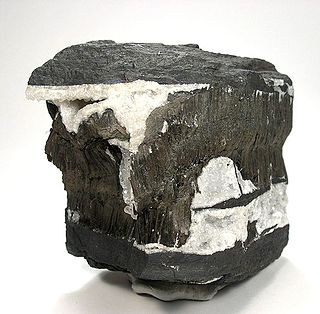
Todorokite is a complex hydrous manganese oxide mineral with generic chemical formula (Na,Ca,K,Ba,Sr)
1-x(Mn,Mg,Al)
6O
12·3-4H
2O. It was named in 1934 for the type locality, the Todoroki mine, Hokkaido, Japan. It belongs to the prismatic class 2/m of the monoclinic crystal system, but the angle β between the a and c axes is close to 90°, making it seem orthorhombic. It is a brown to black mineral which occurs in massive or tuberose forms. It is quite soft with a Mohs hardness of 1.5, and a specific gravity of 3.49 – 3.82. It is a component of deep ocean basin manganese nodules.

Fersman Mineralogical Museum is one of the largest mineral museums of the world, located in Moscow, Russia. Its collections include more than 135,000 items. Among them natural crystals, geodes, druses and other kinds of mineral treasures. The museum was named after Alexander Fersman.
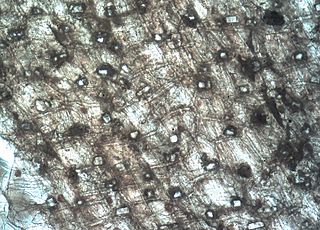
A druse is a group of crystals of calcium oxalate, silicates, or carbonates present in plants, and are thought to be a defense against herbivory due to their toxicity. Calcium oxalate (Ca(COO)2, CaOx) crystals are found in algae, angiosperms and gymnosperms in a total of more than 215 families. These plants accumulate oxalate in the range of 3–80% (w/w) of their dry weight through a biomineralization process in a variety of shapes. Araceae have numerous druses, multi-crystal druses and needle-shaped raphide crystals of CaOx present in the tissue. Druses are also found in leaves and bud scales of Prunus, Rosa, Allium, Vitis, Morus and Phaseolus.
American Mineralogist: An International Journal of Earth and Planetary Materials is a peer-reviewed scientific journal covering the general fields of mineralogy, crystallography, geochemistry, and petrology. It is an official journal of the Mineralogical Society of America, publishing both subscription and open access articles. The journal is a hybrid open-access journal. The editors-in-chief are Hongwu Xu, and Don Baker.

A crystal cluster is a group of crystals which are formed in an open space environment and exhibit euhedral crystal form determined by their internal crystal structure. A cluster of small crystals coating the walls of a cavity are called druse.

Langite is a rare hydrated copper sulfate mineral, with hydroxyl, found almost exclusively in druses of small crystals. It is formed from the oxidation of copper sulfides, and was first described in specimens from Cornwall, United Kingdom. It is dimorphous with wroewolfeite. Langite was discovered in 1864 and named after the physicist and crystallographer Viktor von Lang (1838–1921), who was Professor of Physics at the University of Vienna, Austria.

Wakabayashilite is a rare arsenic, antimony sulfide mineral with formula [(As,Sb)6S9][As4S5].
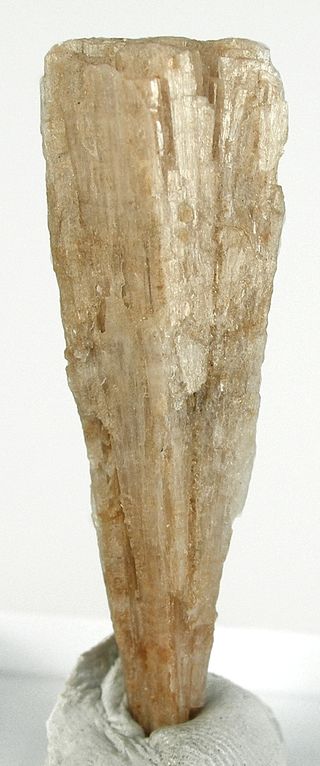
Syngenite is an uncommon potassium calcium sulfate mineral with formula K2Ca(SO4)2·H2O. It forms as prismatic monoclinic crystals and as encrustations.
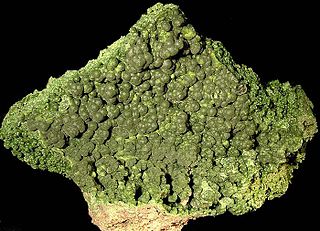
Mottramite is an orthorhombic anhydrous vanadate hydroxide mineral, PbCu(VO4)(OH), at the copper end of the descloizite subgroup. It was formerly called cuprodescloizite or psittacinite (this mineral characterized in 1868 by Frederick Augustus Genth). Duhamelite is a calcium- and bismuth-bearing variety of mottramite, typically with acicular habit.
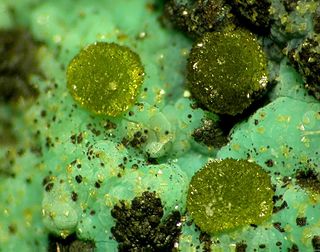
Eulytine (German: Eulytin from Ancient Greek: εΰλυτος, fusible, easily dissolved) or bismuth blende (obsolete) — one of the rarest minerals in nature, the composition is bismuth silicate with the calculation formula Bi4(SiO4)3 or Bi4Si3O12. The mineral forms isometric cubic crystals up to 2 mm in size, the supporting form of which is a tetrahedron or tristetrahedron. Among the varieties, there are also often concentric, fibrous or spherical aggregates of a very impressive appearance, which were previously called agricolites.